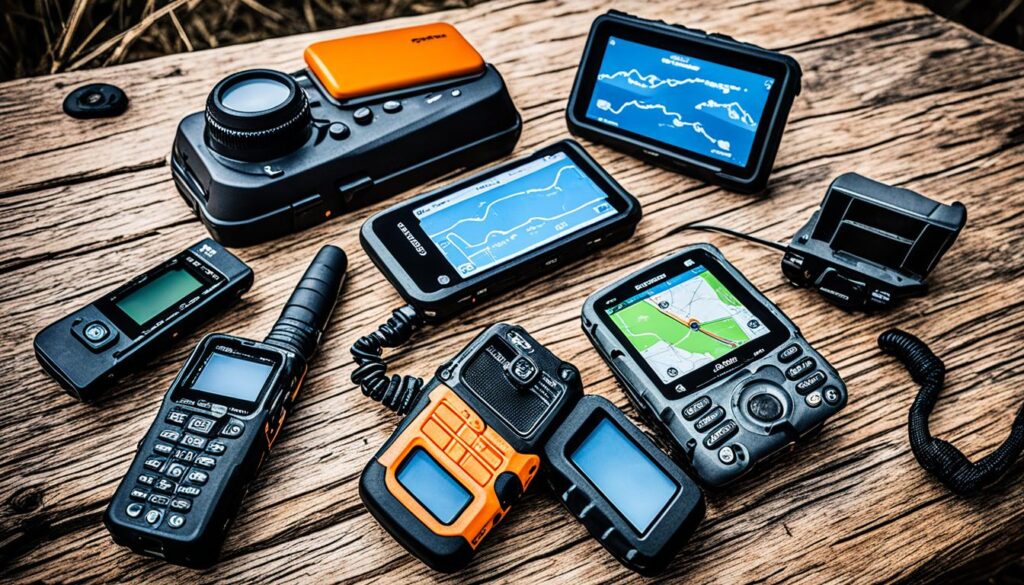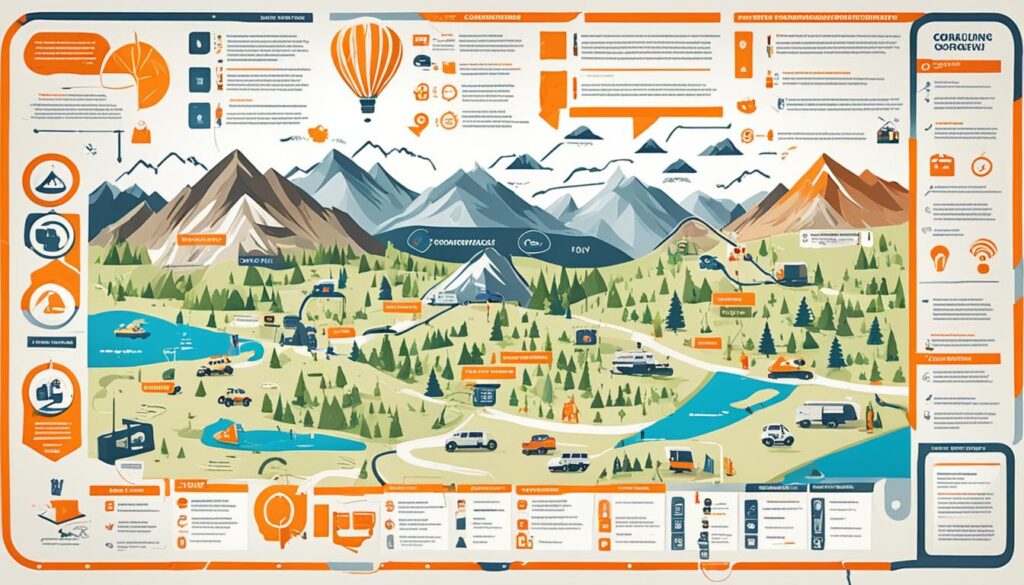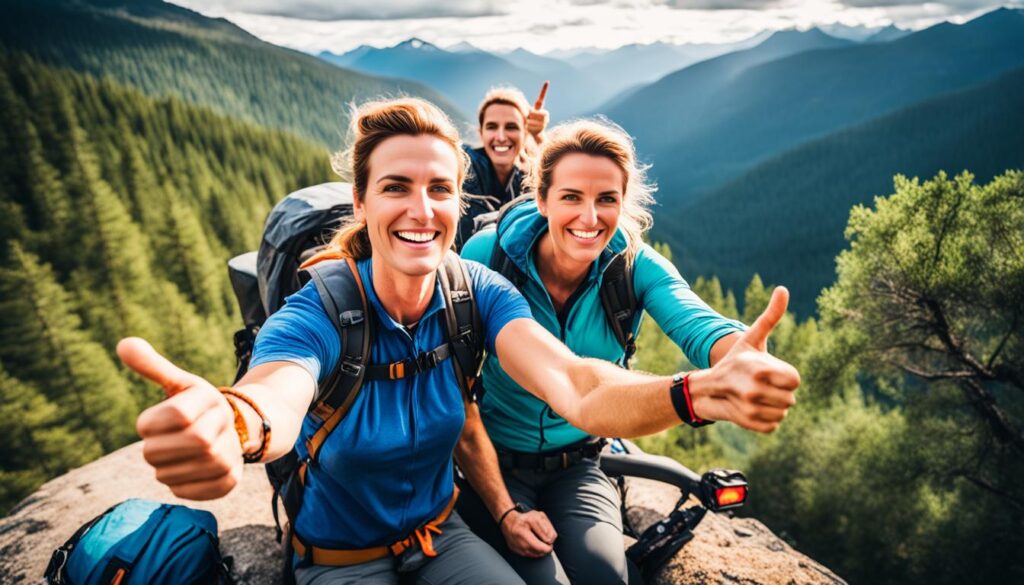How well can you communicate in the great outdoors? When it comes to overlanding, effective communication skills are essential for both safety and enjoyment. Whether you’re exploring rugged terrains, embarking on off-road adventures, or navigating through remote landscapes, the ability to communicate effectively can make all the difference. But what are the best strategies, techniques, and tools for communication in outdoor settings? Let’s dive into the world of overlanding communication and discover expert tips to enhance your outdoor communication game.
Key Takeaways:
- Effective communication is crucial for safety and enjoyment in overlanding.
- Choosing the right communication devices, such as radios or satellite phones, is important.
- Establishing a communication plan with clear roles and responsibilities is essential for coordination.
- Having backup power sources and signal devices ensures reliability in remote areas.
- Staying informed about weather forecasts, road conditions, and using basic sign language enhances communication in the wild.
Contents
Choosing the Right Communication Devices
When it comes to overlanding, having reliable communication devices is essential for staying connected and ensuring safety. There are several options to consider, each with its own advantages and limitations.
Radios:
Radios are a popular choice among overlanders for keeping in touch with their group or other adventurers. There are different types of radios available, including:
- CB Radios: CB radios, or Citizens Band radios, are commonly used for short-range communication. They operate on specific channels and can be a great tool for staying connected with other overlanders in the vicinity.
- FRS Radios: FRS radios, or Family Radio Service radios, provide short-range communication within a few miles. They are often used for family trips or small group adventures.
- GMRS Radios: GMRS radios, or General Mobile Radio Service radios, offer longer range communication, typically up to a few miles, and require a license to operate.
- Ham Radios: Ham radios, or amateur radios, provide long-range communication capabilities and require obtaining an amateur radio license. They are ideal for overlanders who venture into remote or wilderness areas.
Satellite Phones:
Satellite phones are another communication option for overlanders. These devices use satellite technology to provide global coverage, allowing users to make calls and send messages from anywhere in the world. Satellite phones can be a lifeline in emergency situations or when traveling to remote locations with no cellular coverage.
When choosing the right communication device, it’s important to consider factors such as:
- Range: Determine the communication range required for your overland trips to match the device’s capabilities.
- Licensing Requirements: Check if a license is needed to operate certain radios, such as GMRS or amateur radios.
- Budget: Consider the cost of the communication device, including any licensing fees or subscriptions.
By selecting the appropriate communication device for your overland adventures, you can ensure reliable connectivity and enhance safety throughout your journey.

Establishing a Communication Plan
In order to ensure a safe and coordinated overland trip, it is essential to have a well-defined communication plan. This plan outlines the roles and responsibilities within the group, assigns call signs and channel assignments, and includes scheduled check-ins. By establishing a communication plan, overlanders can stay connected and informed throughout their adventure, minimizing confusion and facilitating effective communication.
Roles and Responsibilities
Assigning specific roles and responsibilities within the overland group is crucial for smooth communication. Designating one person as the leader who has overall responsibility for coordinating communication can help streamline the process. Other roles may include a navigator who communicates directions, a safety officer who monitors and reports potential hazards, and a designated radio operator who manages the communication devices.
Call Signs and Channel Assignments
Assigning call signs and channel assignments to each member of the group ensures efficient communication. Call signs are unique names used to identify individuals over the radio or other communication devices. These can be based on initials, nicknames, or any other identifier that is easy to remember. Channel assignments determine which frequency or channel each member should tune their communication device to for seamless communication. By standardizing call signs and channel assignments, overlanders can easily reach each other without confusion or interference.
Scheduled Check-ins
Scheduled check-ins are an integral part of the communication plan, especially for larger groups or trips with multiple vehicles. These check-ins can be pre-determined times or specific landmarks along the route. They ensure that the group stays connected and allows for a quick assessment of everyone’s status and well-being. Checking in at regular intervals reduces the risk of someone becoming separated or encountering difficulties without support.
Effective communication is the backbone of a successful overland trip. Establishing a communication plan with clearly defined roles, call signs, channel assignments, and scheduled check-ins ensures that everyone stays connected and informed. It is a vital aspect of enhancing safety and coordination throughout the adventure.

Having a communication plan in place is essential when embarking on an overland adventure. It enables efficient and effective communication, ensuring the safety and well-being of all participants. By defining roles and responsibilities, assigning call signs and channel assignments, and conducting scheduled check-ins, the entire group can stay connected and informed throughout the journey.Remember, a well-executed communication plan minimizes confusion, enhances coordination, and maximizes the overall experience of the overland trip.
Backing Up Power and Signal Devices
When it comes to overlanding communication, being prepared with backup power sources is essential. You don’t want to be caught off-guard with dead batteries or drained devices in the middle of nowhere. Having backup power options ensures that you can stay connected and maintain communication even in remote areas where traditional methods may fail.
To ensure your communication devices stay operational, here are some essential backup power solutions:
- Spare batteries: Carrying spare batteries for your communication devices is a simple yet effective backup solution. Make sure to pack extras for all your devices and keep them organized and easily accessible.
- Power banks: Power banks are portable battery packs that can charge your devices on the go. These compact and lightweight backup power sources are perfect for overlanding trips when access to electricity may be limited.
- Solar chargers: Harness the power of the sun with solar chargers. These devices use solar panels to convert sunlight into electricity, allowing you to charge your communication devices wherever there is sunlight. Ideal for extended trips or when you’re off the grid for an extended period.
In addition to backup power, equipping yourself with signal devices can be a lifesaver in emergency situations. When conventional communication methods fail, these devices can attract attention and signal for help. Here are some recommended signal devices:
- Flares: Flares are bright, attention-grabbing signals that can be seen from a distance. They are particularly useful during nighttime or low visibility conditions.
- Smoke signals: Smoke signals are effective in both day and night situations. By creating a column of smoke, you can quickly alert others to your location or communicate with potential rescuers.
- Signal mirrors: Signal mirrors use reflected sunlight to create flashes that can be seen from miles away. They are lightweight, compact, and easy to use, making them an excellent addition to your emergency signaling kit.
By having backup power sources and signal devices readily available, you can ensure that your overlanding communication remains robust, even in challenging situations. These preparations provide an extra layer of safety and peace of mind, allowing you to focus on enjoying your adventure.
Staying Informed and Using Basic Sign Language
When embarking on an overland adventure, staying informed about weather forecasts, road conditions, and potential hazards is crucial for a safe and successful journey. Knowing what lies ahead allows overlanders to make informed decisions and adjust their plans accordingly. Keeping up-to-date with the latest weather forecasts helps them prepare for changing conditions and avoid potential risks.
Furthermore, having accurate information about road conditions enables overlanders to choose the most suitable routes and avoid roads that may be impassable or unsafe. By staying informed and adapting to the ever-changing conditions, overlanders can navigate with confidence and minimize the chances of encountering unnecessary challenges or setbacks.
Another vital aspect of effective communication in the wild is using basic sign language. Learning simple hand gestures and signals allows overlanders to convey important messages without disturbing the tranquility of the wilderness. Basic sign language can be used to communicate essential information such as danger ahead, the need for assistance, or even basic requests like food or water. By utilizing basic sign language, overlanders can enhance their communication abilities and ensure the safety of themselves and their team.
Staying informed and utilizing basic sign language are vital skills for any overlander. By remaining up-to-date with weather forecasts, road conditions, and potential hazards, as well as incorporating basic sign language into their communication strategy, overlanders can enjoy a safer and more rewarding experience in the great outdoors.
FAQ
What are some effective communication tips for overlanding?
It is important to choose the right communication devices, establish a communication plan, backup power and signal devices, and stay informed about weather forecasts and road conditions. Learning basic sign language can also enhance communication in outdoor settings.
What communication devices are commonly used in overlanding?
Popular communication devices for overlanding include CB radios, FRS radios, GMRS radios, ham radios, and satellite phones.
Why is it important to establish a communication plan for overlanding adventures?
A communication plan outlines roles and responsibilities within the group, assigns call signs and channel assignments, and includes scheduled check-ins. It ensures that everyone knows how to reach each other and minimizes confusion, especially for larger groups or trips with multiple vehicles.
How do I backup power and signal devices while overlanding?
It is crucial to carry spare batteries, power banks, or solar chargers to keep communication devices operational. Additionally, signal devices such as flares, smoke signals, and signal mirrors can be valuable tools to attract attention and communicate distress signals in emergencies.
How can I stay informed and communicate effectively in adventurous environments?
It is important to stay informed about weather forecasts, road conditions, and potential hazards to make informed decisions. Learning basic sign language can also be helpful as it provides a silent way to convey important messages without disturbing the tranquility of the wilderness.






